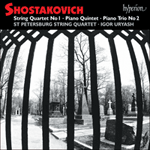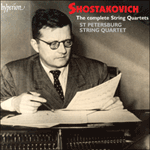
Welcome to Hyperion Records, a British classical label devoted to presenting high-quality recordings of music of all styles and from all periods from the twelfth century to the twenty-first.
Hyperion offers both CDs, and downloads in a number of formats. The site is also available in several languages.
Please use the dropdown buttons to set your preferred options, or use the checkbox to accept the defaults.

| St Petersburg String Quartet, Igor Uryash (piano)» More |
The first movement begins with an unearthly fragment of a fugue, the cello playing high, eerie harmonics, the muted violin entering below, the piano following with deep octaves. This is Shostakovich at his bleakest. A sudden increase in pace brings not relief, but a heightening of anxiety. The motif with which the work began is thrown from instrument to instrument, there are sudden climaxes, and the movement peters out uncertainly just as one expects some new development. The second movement is savagely ironic, taking the witty conventions of a scherzo and subjecting them to biting discords and obsessive repetition. In the middle of the movement, the violin flings fragments of a folk song high in the air, but the effect is desperate rather than joyful. The third movement is a passacaglia: the piano repeats a slow, stark sequence of chords six times. Above the chords the violin and then the cello enter, like figures in a ruin rescuing fragments of musical memories—unaccompanied Bach, perhaps. The music slowly builds to a climax, subsides to an inconclusive chord, and then launches straight into the finale. This brings together all the moods of the earlier movements—the bleakness of the opening, the bitter irony of the scherzo, the searching lament of the passacaglia. To these it adds a specifically Jewish element, for this is Klezmer, the wild music of Jewish celebration, here grotesquely metamorphosed into an image of sustained destructive power. At the final climax it breaks off, and a swirling pattern based on the passacaglia leads in a desperate reminiscence of the first movement, as if the terrible vision of the finale was foretold right at the beginning of the work. And at the end the chords of the passacaglia come together with the eerie harmonics from the very opening, leaving the bleak landscape as empty as when we entered it.
Whatever detailed programme or narrative Shostakovich may have had in his mind when writing the Trio is secondary to the direct impact of the music. In Testimony, the volume of memoirs assembled by Solomon Volkov, but now much disputed, Shostakovich is reported as saying: ‘I am horrified by people who think the commentaries to a symphony are more important than the symphony. What counts with them is a large number of brave words—and the music can be pathetic and woebegone. This is real perversion. I don’t need brave words on music and I don’t think anyone does. We need brave music.’ That sounds like Shostakovich.
from notes by Robert Philip © 2011
Le premier mouvement s’ouvre sur un mystérieux fragment de fugue: le violoncelle exécute des harmoniques aigus, inquiétants et le violon avec sourdine entre par-dessous, suivi du piano avec des octaves graves. Voilà Chostakovitch à son plus maussade. Une brusque augmentation de tempo, loin d’apporter le moindre soulagement, exacerbe l’angoisse. Le motif inaugural est lancé d’instrument en instrument, les apogées sont brusques et le mouvement s’évanouit avec hésitation, alors même que l’on s’attend à un nouveau développement. Le deuxième mouvement, sauvagement ironique, soumet les verveuses conventions du scherzo à de mordantes discordances et à une répétition obsessionnelle. Au beau milieu, le violon lance haut en l’air des fragments de chant populaire, mais l’effet est plus désespéré que joyeux. Le troisième mouvement est une passacaille: le piano redit six fois une lente et austère séquence d’accords, par-dessus lesquels le violon puis le violoncelle font leur entrée, tels des personnages sauvant d’une ruine des bribes de souvenirs musicaux—Bach sans accompagnement, peut-être. La musique aboutit lentement à un apogée et s’efface dans un accord peu probant avant de se jeter droit dans le finale où sont réunis les climats des mouvements précédents—l’austérité du début, l’ironie amère du scherzo et la lamentation pénétrante de la passacaille plus un élément spécifiquement juif, car voilà du klezmer, la musique débridée des célébrations juives, ici grotesquement métamorphosée en une image d’une implacable puissance destructrice. Au paroxysme final, c’est l’arrêt, puis un schéma tourbillonnant, fondé sur la passacaille, mène à une réminiscence désespérée du premier mouvement, comme si la terrible vision du finale était prédite d’entrée. À la fin, les accords de la passacaille surviennent avec les lugubres harmoniques du tout début, laissant le morne paysage aussi vide qu’en entrant.
Quel que fût le programme ou le récit détaillé auquel Chostakovitch pensa en écrivant son Trio, il est secondaire par rapport à l’impact direct de la musique. Dans Témoignage, le désormais fort controversé volume de mémoires réuni par Solomon Volkov, Chostakovitch aurait déclaré: «Je suis horrifié par les gens qui pensent que les commentaries sur une symphonie importent plus que la symphonie. Ce qui compte avec eux, c’est un grand nombre de beaux mots—et la musique peut être pathétique et désolée. C’est là une réelle perversion. Je n’ai pas besoin de beaux mots sur la musique et je ne pense pas que quiconque en ait besoin. Ce qu’il nous faut, c’est de la belle musique.» Voilà qui ressemble bien à du Chostakovitch.
extrait des notes rédigées par Robert Philip © 2011
Français: Hypérion
Der erste Satz beginnt mit einem unheimlichen Fugenfragment, wobei das Cello hohe, schaurige Flageoletttöne spielt, die gedämpfte Violine darunter einsetzt und das Klavier mit tiefen Oktaven folgt. Es ist dies die trostloseste Musik Schostakowitschs. Eine plötzliche Beschleunigung des Tempos sorgt nicht für Erleichterung, sondern für noch stärkere Beklemmung. Das Anfangsmotiv wird von Instrument zu Instrument geworfen, es gibt plötzliche Höhepunkte und der Satz geht ungewiss dem Ende zu, wenn man eigentlich etwas Neues erwarten würde. Der zweite Satz ist wild-ironisch; die geistreichen Konventionen eines Scherzos werden hier mit beißenden Missklängen und obsessiven Repetitionen umgeformt. In der Mitte des Satzes wirft die Violine Fragmente eines Volkslieds hoch in die Luft, doch ist der Effekt eher ein verzweifelter als ein fröhlicher. Der dritte Satz ist eine Passacaglia: das Klavier wiederholt sechsmal eine langsame, kahle Sequenz von Akkorden. Oberhalb der Akkorde setzen zuerst die Geige und dann das Cello ein wie Figuren in einer Ruine, die Fragmente von musikalischen Erinnerungen retten—unbegleiteter Bach vielleicht. Die Musik steuert langsam auf einen Höhepunkt hin, sinkt in einen ergebnislosen Akkord hinab und geht dann direkt in das Finale über. Hier kommen alle Stimmungen der vorangehenden Sätze vor—die Trostlosigkeit des Beginns, die bittere Ironie des Scherzos, das suchende Lamento der Passacaglia. Dazu gesellt sich ein spezifisch jüdisches Element, der Klezmer: die wilde Musik jüdischer Feiern, die hier jedoch in grotesker Weise in ein Bild anhaltender destruktiver Kraft umgewandelt ist. Beim letzten Höhepunkt bricht es ab und eine umherwirbelnde Figur, die sich auf die Passacaglia bezieht, leitet zu einer verzweifelten Erinnerung an den ersten Satz hinüber, als ob die furchtbare Vision des Finales schon zu Beginn des Werks vorausgesagt worden sei. Und am Ende erklingen die Akkorde der Passacaglia zusammen mit den schaurigen Flageoletttönen von ganz zu Anfang, so dass die trostlose Landschaft ebenso leer hinterlassen wird, wie sie zu Beginn aufgefunden wurde.
Wenn Schostakowitsch ein detailliertes Programm oder eine Erzählung im Sinn hatte, als er das Trio schrieb, so ist dies der direkten Wirkung der Musik gegenüber sekundär. In Testimony [Zeugnis], der von Solomon Volkov zusammengestellte Memoiren-Band, der heutzutage jedoch sehr umstritten ist, wird Schostakowitsch folgendermaßen zitiert: „Ich bin entsetzt über die Menschen, die meinen, dass die Kommentare über eine Symphonie wichtiger seien, als die Symphonie selbst. Was für sie zählt, ist eine große Anzahl von mutigen Worten—und die Musik kann erbärmlich und jammervoll sein. Das ist echte Perversion. Ich brauche keine mutigen Worte über Musik und ich glaube auch nicht, dass sie sonst jemand braucht. Wir brauchen mutige Musik.“ Das klingt nach Schostakowitsch.
aus dem Begleittext von Robert Philip © 2011
Deutsch: Viola Scheffel
 Shostakovich: Quartet No. 1, Quintet & Trio No. 2 Shostakovich: Quartet No. 1, Quintet & Trio No. 2‘Igor Uryash is exemplary, striking the right balance between the demands of soloist and chamber player … Hyperion's recording is beautifully bal ... ‘With a superb recording to boot, this release provides an extremely fitting conclusion to the St Petersburg's excellent Shostakovich cycle’ (BBC Musi ...» More |
 Shostakovich: The Complete String Quartets Shostakovich: The Complete String Quartets‘These players approach Shostakovich's mighty cycle with a natural authority that's unanswerable, along with tireless precision and virtuosity, plus a ... ‘The St Petersburg musicians play with tremendous control of technique and expression; the effect is one of huge emotional strength’ (Birmingham Post)» More |

